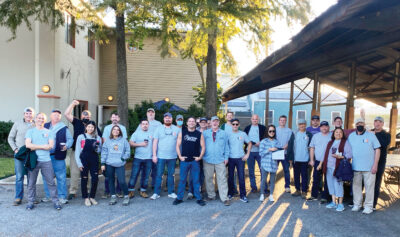Wood flooring professionals have many issues to consider when beginning any job. Some are obvious, like getting the material to the job site, and scheduling the work, but other issues are not quite as obvious.
An example is understanding the laws impacting our industry. Specific legislation varies by region, but there are several issues that affect every wood flooring job: formaldehyde, lead, asbestos, and silica.
Formaldehyde is a volatile organic compound used in chemical substances, including flooring adhesives and finishes. Because formaldehyde can be dangerous at high levels, emissions are regulated in the U.S. by the California Air Resources Board (CARB).
In 2009, CARB established formaldehyde emissions standards for composite wood products. The standards are enforceable legally only in California; however, most producers sell CARB compliant flooring, and the U.S. and Canadian governments are using CARB as a model to establish national standards.
Current CARB regulations require that certified composite wood panels meet specified emissions performance standards. All mills producing such panels are required to have third-party certification that their production procedures are compliant.
CARB formaldehyde emission limits are set at 0.05 parts per million for Hardwood plywood, 0.11 parts per million for MDF that is more than 8mm thick, and 0.13 parts per million for MDF that is 8mm thick or less. CARB also regulates particleboard at 0.09 parts per million.
Everyone in the supply chain must follow specific documentary procedures to maintain a chain of custody for the product purchased. This documentation traces the product back to the original panel manufacturer. These records should be kept for a minimum of two years.
Lead is another issue that requires the attention of wood flooring professionals. It is a naturally occurring chemical element that can be poisonous to humans if it is ingested or inhaled.
Until the late 1970s, construction products, like paint, often contained lead. When lead is disturbed during renovation, repair, or painting activities, dangerous amounts of lead dust can be released. Because of this danger, the U.S. Environmental Protection Agency (EPA) requires that when renovating, repairing, or painting homes built prior to 1978, they must be tested for lead. This requirement also applies to any non-residential building that primarily serves children, like a school or day care.
Wood flooring contractors have to be concerned with two specific areas in structures built prior to 1978. First, if more than 6 square feet of any painted surface is disturbed (including baseboards), it must be tested for lead. Second, if the type of finish on the floors is unknown, it must be tested for lead.
Testing must take place before any work begins, but, before testing occurs, the company must be certified to do so by the EPA. Learn more at epa.gov/lead/renovation-repair-and-painting-program.
If testing shows that lead is present, lead-safe work practices must be implemented. To accomplish this, both the company and the individual doing the work must be trained by the EPA.
There are other procedures that must be followed for lead abatement as well, including customer education and project documentation. Learn more at epa.gov/lead.
Like lead, asbestos was a common material used in construction, until the late 1980s. It is a naturally occurring silicate mineral composed of thin, fibrous crystals that can be released through abrasion processes, like sanding. When inhaled over long periods of time, exposure can result in serious and sometimes fatal conditions. As a result, asbestos is no longer approved as a modern-day construction material.
Like lead, however, asbestos is already in many older structures. Because of this, the EPA requires that structures built prior to 1986 be tested for asbestos. When asbestors is present, it must be removed safely. Many states have their own laws regarding asbestos removal. Learn more at epa.gov/asbestos/state-asbestos-contacts.
Crystalline silica is another regulated substance in our industry. It is a common mineral that is a natural part of the Earth’s crust. It is found in materials like soil, sand, and stone, and is used to produce many man-made materials, including concrete.
Inhaling silica dust can be harmful to humans. Short-term exposure poses little to no risk, but long-term exposure can result in serious illnesses like silicosis, lung cancer, chronic obstructive pulmonary disease, and kidney disease. Because of this, the Occupational Safety and Health Administration (OSHA) established standards for crystalline silica in construction.
In the wood flooring industry, the most common source of silica dust is from grinding concrete to level a concrete subfloor in preparation for wood floor installation. To meet OSHA standards, floor grinders must be used according to manufacturer recommendations to minimize dust emissions; dust collection systems must provide air flow as recommended by the manufacturer and have a filter with greater than or equal to 99 percent efficiency as well as a filter-cleaning mechanism; in enclosed areas, exhaust systems must be used to minimize dust accumulation; and a HEPA-filtered vacuum must be used to remove loose dust in between each pass.
In addition to these requirements, employers must establish and implement a written exposure control plan; designate someone to monitor the plan; restrict practices that increase exposure; offer medical exams for exposed employees; train workers to identify and limit exposure; and maintain records for exposure, medical exams, and other related data. Learn more at osha.gov/Publications/OSHA3902.pdf.
It is important to note that failure to comply with laws regulating any of these substances can result in severe fines.The National Wood Flooring Association has detailed information about regulations affecting our industry available through NWFA University, an online training platform that is convenient and affordable. More information is available at nwfa.org/nwfa-university.aspx.









